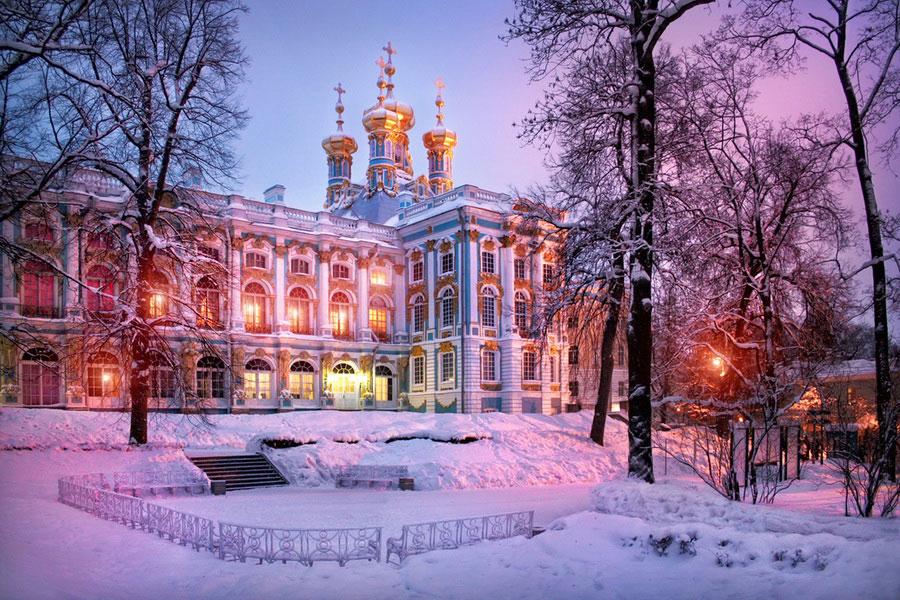
About Tsarskoye Selo
Every school child knows about Tsarskoye Selo (Tsar's Village) where the imperial family lived and the great Russian poet, Alexander Pushkin used to live. Today Tsarskoye Selo is not indicated in maps; instead of it you will find the town of Pushkin. It is located twenty kilometers from St. Petersburg. Despite the new name for the area formerly known as Tsarskoye Selo the atmosphere of Russia’s Golden Age has been preserved. The name Tsarskoye was not given to the place because of the affiliation of the imperial family. Long time ago these territories were a part of Sweden and were called Sarskaya manor. The beauty of this place charmed Peter I and he gave it to his wife, the future Empress Catherine I. Then it became known as Sarskoye Selo and later - Tsarskoye. The beginning of the town dates from 1710. From that time the process of palaces and parks creation started. In the 18th - early 20th centuries Tsarskoe Selo was the summer residence of the Emperor's residence. From 1811 to 1843 there was Tsarskoselsky School where A.S. Pushkin studied.
Only in the beginning of the 19th century Tsar's Village was officially recognized as the town. I In 1937, the 100th anniversary of Pushkin’s death, Tsar's village got its present name, the town of Pushkin which became the historical and architectural reserve. The most remarkable landmarks of Pushkin are the majestic Catherine Palace and magnificent Alexander’s Palace.
Catherine’s Palace
The spectacular palace of the first Tsarskoye Selo mistress, Empress Catherine I, was executed in the style of Russian Baroque and enthralls with its splendor. The current version of the palace appeared in the second half of the 18th century. The previous version was far more modest. The facade of the palace attracts attention with its bright expressive colors against which the white stucco decorations, figurines, and ornaments are clearly seen. However, the palace interior makes people wow with delight. Each room is decorated with authentic antiques. The collection includes the great variety of unique artifacts of decorative art, furniture, porcelain, statues, paintings and more including personal belongings of Russian emperors and their families. Speaking of the inner rooms it is worth mentioning the world’s famous Amber Room. The history of its disappearance is one of the most mysterious puzzles of the last century. Information: the Amber Room given as gift to Peter I by King of Prussia was stolen during the Second World War. The futile quest of the masterpiece forced Russian artists to revive the room on the basis of photos and other documents. The work went on for 25 years. The Official opening ceremony of the restored Amber Room was held on 31 May 2003 and was timed to celebrate the 300th anniversary of St. Petersburg. The amber panels made from hand-polished pieces of different colors and sizes include frames, garlands, and coats of arms, wreathes, monograms and even entire scenes from the Bible. The palace is surrounded by magnificent picturesque Catherine Park.
Alexander’s Palace
This palace was given by Empress Catherine II to her first grandson, Alexander I, after his marriage to Princess Elizabeth. The famous Italian architect Giacomo Quarenghi constructed the beautiful palace building in the classical style in 1796. The Palace has only two floors but because of its big length it looks very monumental. The center of the main facade is decorated with magnificent colonnade of two rows of columns. The interiors of the palace are designed in the classical style. Alexander’s Palace was the residence of the future Emperor Alexander III. After the revolution of 1905, it became the permanent residence of the last Russian emperor Nicholas II. It was in this palace that 22 years of the last Russian emperor were spent. From there the royal family was sent into exile. Alexander’s palace was restored after numerous destructions during World War II. An integral part of the museum-reserve Tsarskoye Selo is a number of parks. On the territory of 1 482.63 acres three parks are located. In the parks of Pushkin there are more than 100 architectural monuments - the palaces, pavilions, bridges, marble monuments, imitating the Gothic, Turkish, and Chinese architecture. Small pavilions and bridges across the canals coexist with the solemn palaces.

